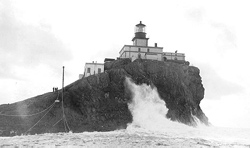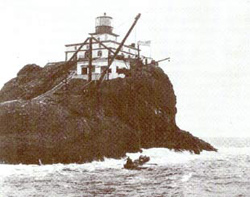 |
Back to Oregon Coast
Freaky Facts About Oregon Coast Lighthouses
 |
| Cape Meares Lighthouse, near Tillamook |
(Oregon Coast) - They are the stuff legends are made of, and often ghost stories appear through these lore. Oregon's lighthouses are some of the state’s biggest tourist attractions, with hundreds of thousands visiting its dozen big beacons every year. Most are open to tours, but a few are not, and this only adds to th mystery and legend.
Standing sometimes hundreds of feet tall, they hearken back to a simpler time that is more and more engaging as the years put distance between those decades and us. They fire the imagination and cause us to fill in the blanks on the existence of these stately monuments, of which we usually know very little. Often, what we do know begs more questions than it answers, and thus the stories are born.
Like much of history, and certainly the vast majority of scientific facts, the reality about Oregon coast lighthouses is very much stranger than the stories. Five of Oregon’s lighthouses are covered here: Tillamook Rock, lying a mile offshore from Cannon Beach and Seaside; Cape Meares near Tillamook; the two lighthouses in Newport; and Heceta Head, just north of Florence. There are more southward, but these are a handful by themselves, with all their kooky facts.
Tillamook Rock Lighthouse
 |
| Tillamook Rock Lighthouse as it was |
The truth behind this lighthouse is certainly weirder than fiction itself – or any of its ghost tales, for that matter. It’s never been accessible to the public, and thus has always sparked the imagination with its mysterious silhouette lying more than a mile away.
Construction on this blob of rock began in the 1880’s, after initial plans were scrapped to put it on a fog-prone, blind spot area atop Tillamook Head. Things didn’t start well. The first man to step on the rock to do some surveying drowned, creating an immediate public outcry that perhaps this wasn’t a good idea.
After the top was blasted, construction crews had to endure insane conditions, living under soggy tents and enormous waves that constantly knocked at them. The crews lived in rotating shifts on the rock, and there were so many casualties in these conditions that men waiting onshore to work there were actually sequestered away from the public and from talk of what went on there.
The barons in charge of the project went to incredible lengths to keep construction workers away from the truth. They were housed in various places along the southern Washington coast, away from Seaside, and for a while even on a ship anchored just offshore.
Lightkeepers lived there in shifts too: four of them, usually a few months at a time. It was a brutal existence, and one keeper reportedly went mad from the solitude.
 A giant winch was used to bring supplies and personnel from visiting ships to the rock, which was a dangerous and unwieldy endeavor under even the best conditions. They were put inside an object called a breeches buoy – which is essentially a giant pair of pants encircled by a floatation ring, attached to the cables overhead. Numerous men were lost doing this.
A giant winch was used to bring supplies and personnel from visiting ships to the rock, which was a dangerous and unwieldy endeavor under even the best conditions. They were put inside an object called a breeches buoy – which is essentially a giant pair of pants encircled by a floatation ring, attached to the cables overhead. Numerous men were lost doing this.
The place was ripe for ghost stories. It didn’t help that local tribes purportedly said it was inhabited by evil spirits.
There are rumors of ghost tales over the years, including the claims of voices heard over the din of storms from the lens area and other isolated or dark parts of the lighthouse. Sometimes, stories about ghost ships appearing in the fog and drifting past are associated with the place as well, but usually these have foundations in actual events involving near misses from real ships.
Indeed, a ship called the Lupatia nearly hit the lighthouse in dense fog, but was warned away just in time. However, it did soon after slam into Tillamook Head, killing all aboard except the ship’s dog.
One local legend has it that you can sometimes still hear the dog howl in the night near Tillamook Head.
Another almost spooky tale from the lighthouse comes from a keeper who felt something brush past his face in the dark while lying in bed. All of a sudden, he heard strange footsteps in the pitch black, and after a time, bolted towards the light switch, arms swinging wildly in an attempt to smack whatever trespasser was there. When he turned on the light, he found only an injured bird that had somehow made its way into his bedroom. The odd footsteps were its broken wing hitting the floor.
The lighthouse was decommissioned in 1957, with the last keeper, Oswald Allik, proclaiming “I return thee to the elements.”
 |
| The lighthouse today, seen from Cannon Beach |
One of those who served aboard the lighthouse was U.S. Coast Guard officer Jim Gibbs, who later became a famous writer on maritime subjects, including this lighthouse and Oregon coast shipwrecks. Gibbs has own lighthouse now, having turned his home near Yachats into an actual working lighthouse that can be seen at sea. Mariners say they actually appreciate its presence.
In the 80’s, after numerous failed ownerships, a firm called Eternity at Sea bought the Tillamook Rock lighthouse property, and it now serves as a columbarium – a place for ashes of the dead.
Rather comically, that firm ran ads in the early 90’s or so offering free satellite TV for life – if you reserved your resting place early. Presumably, they figured if you were making such arrangements you wouldn’t be around too long.
Cape Meares Lighthouse
 It’s the shortest of the coast’s lights, standing at a stumpy 38 feet high. But no matter, the cliff is more than a couple hundred feet high, making it the highest standing lighthouse in the end.
It’s the shortest of the coast’s lights, standing at a stumpy 38 feet high. But no matter, the cliff is more than a couple hundred feet high, making it the highest standing lighthouse in the end.
Back in 1890, it was constructed of bricks that were made right on the spot, along with iron plates that had to be hauled by wagon from Portland over the bumpy terrain of the coast range. The first order Fresnel lens was imported from Paris, France, shipped around Cape Horn, up the west coast to Cape Meares and then brought up 217 feet from a boat below the cliff by a wooden crane.
The keepers quarters were originally located where the parking lot is now, about a quarter mile away. The light was decommissioned in 1963, and eventually taken over by the group that watches over it today, after some serious vandalism to the structure nearly meant its complete demise.
Yaquina Head Lighthouse
 |
| Yaquina Head Ligthouse getting worked on in 2005 |
The fun thing about Newport is that there are two lighthouses in town. This one is the tallest structure on the coast, sitting at the tip of Yaquina Head.
There has been considerable debate over the last 100 years or so that Yaquina Head’s lighthouse was accidentally built in the wrong place. Supposedly, the theory goes that due to some typographical error in the plans, it was built there instead of towering Cape Foulweather, about 10 miles north.
Not so, says Scott Gibson, producer of the documentary “Oregon Lights” (which is now for sale on DVD). “Basically, there's no reason a lighthouse as tall as Yaquina Head would need to be placed high atop Cape Foulweather where it would be in the fog line much of the time,” Gibson said.
Another fun and funky factoid about this lighthouse: a Hollywood crew from the old “Hardy Boys” TV show came to the lighthouse in the 70’s to film a Halloween episode, complete with lots of cobwebs and other spooky accoutrements scattered around the lighthouse. The group in charge of the lighthouse at the time had to sue the Hollywood crew to come and clean things up, as they left it in a shambles with all the new decorations.
Yaquina Bay Lighthouse
 |
| Moody Yaquina Bay Ligthouse |
This one was only active for about three years in the late 1800’s, when the building of its neighbor to the north ended the need. The place started to decay fairly quickly, and really fell into serious, even creepy, disrepair by the early part of the 20th century.
Somewhere in there, a tale got started about the ghost of a teenaged girl named Muriel, who had fallen to her death while being chased by pirates. One version involves a secret passageway into a hidden cavern beneath the lighthouse where she supposedly fell.
This tale has her wandering the beaches as well, appearing out of the fog.
However, it turns out this one was only a fictional short story written by an imaginative local around the turn of the century. What is interesting to note, however, is that until local historians found the original short story in the 80’s, it had somehow weaved itself into local lore as a real ghost story. Even book authors took the tale seriously as late as the 70’s.
Heceta Head Lighthouse
 This lighthouse near Florence is one of the only ones on the coast to still have its keeper’s quarters. They’ve been turned into a charming little B&B, and it’s on the national historic registry. It’s also known as one of the most photographed lighthouses in the world.
This lighthouse near Florence is one of the only ones on the coast to still have its keeper’s quarters. They’ve been turned into a charming little B&B, and it’s on the national historic registry. It’s also known as one of the most photographed lighthouses in the world.
It’s notorious for being haunted, however. Indeed, Coastal Living Magazine recently named it one of the top ten haunted lighthouses in the nation. The stories surrounding this haunting are supported by some credible sources, including the family which runs the B&B.
Back in the early part of the century, state officials had to blast away a chunk of rock beneath the lighthouse, as beachgoers constantly got themselves stranded on a rocky shelf area that would easily get surrounded by the tide.
Find Oregon Coast hotels, hotels, lodging.....
Secrets of the Season |
Unusual Travel Articles TravelParanormal.com allows you to submit your own creepy tale or debunk one - or see up-to-the-minute news headlines about travel and the paranormal. News Headlines from All Over Oregon Need to scan Oregon headlines? Constantly updated news from all over Oregon: a comprehensive, up-to-the-minute display of news headlines from a variety of media |






































